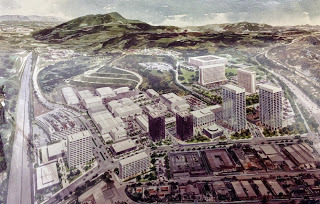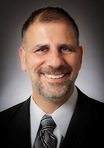Universal Studios Hollywood 1997 Expansion Effort
 CityWalk had been in operation for three years by 1996 and Universal began considering an expansion. The shopping and entertainment center may have taken a critical beating but it was a hit with the public and good for Universal’s bottom line. “Universal City’s hilltop operates as one big mega theme park made up of three paid gates all supported and reinforced by a free entry festival marketplace," according to Buzz Price. "It is in the same genre as Harborplace in Baltimore which contains three paid gates (the aquarium, the science museum and IMAX, and the USS Constitution) operating in concert with a major festival marketplace. It is also in the same genre as Knott’s theme park with its festival market outside the gate.” The result was total attendance in 1995 for all venues over 15 million making it the 4th largest park in the US. Price called it a mega park.
CityWalk had been in operation for three years by 1996 and Universal began considering an expansion. The shopping and entertainment center may have taken a critical beating but it was a hit with the public and good for Universal’s bottom line. “Universal City’s hilltop operates as one big mega theme park made up of three paid gates all supported and reinforced by a free entry festival marketplace," according to Buzz Price. "It is in the same genre as Harborplace in Baltimore which contains three paid gates (the aquarium, the science museum and IMAX, and the USS Constitution) operating in concert with a major festival marketplace. It is also in the same genre as Knott’s theme park with its festival market outside the gate.” The result was total attendance in 1995 for all venues over 15 million making it the 4th largest park in the US. Price called it a mega park. The Studio Tour benefited with CityWalk. The number of locals crossing over and visiting the Studio Tour had increased dramatically. This change was vital to the long-term sustainability for the Studio Tour and would become the foundation for Universal Hollywood’s transformation from an industrial tour to a full fledge theme park.
CityWalk also brought new vitality to the Cineplex. Attendance skyrocketed now that is was not so isolated. In 1996, Price had recommended adding an IMAX large screen format theater, which would happen a few years later.
A 1996 study showed that demand far outstripped capacity. In fact, the study suggested Universal could double the size of CityWalk. If Universal built it, the public would come. Buzz Price said, “The demand for expansion is obviously there. It’s a slam-dunk.” Price noticed that the success of CityWalk meant, “The old battle between the tour people who thought that the Tour was the mother of all profits and the periphery development team was obsolete. It was one dynamic place, one of a kind." The study also suggested that Universal should take over many of the store leases to cut out the middle man and to operate the themed restaurants as joint ventures to maximize profits.
On July 12, 1996, Disneyland officials met with local leaders in the Disneyland Opera House to unveil plans for expansion their Anaheim property. As announced, the new Disneyland Resort would include Disney’s California Adventure—a 55-acre theme park—the 750-room Disney’s Grand Californian Hotel that would face into the park, and a 200,000 square-foot Disneyland Center shopping and entertainment district. The goal was to turn the area into a multiday tourist resort like Walt Disney World. Disney was growing increasingly concerned that the constant regional discounting and annual passes had started to turn the park into a regional theme park rather than a world-class destination.Not to be outdone, Universal announced expansion plans of its own on January 21, 1997 at a public hearing before the Los Angeles County Planning Commission. The meeting was held at the Universal Hilton Ballroom and the studio provided free food. A pro-development group called Universal City Tomorrow attended to balance out any neighborhood objections.
The twenty-five year plan was estimated to cost $2 billion and would create up to 13,000 permanent jobs. The plan outlined four development sites; the Studio District, the Business Center, the Entertainment district, and Greenscape district. Overall, the project would create almost 5.9 million square feet of new development.
Enhancements to the Studio and Business Center districts would include additional soundstages, post production studios, and office space. Many of those projects would be placed near Lankershim Boulevard. A new heliport was also part of the proposal.
New attractions would be added to the the Entertainment district including a new 750,000 square foot children's theme park. New water rides, lakes, and water features would be used to tie together the decorative elements. For example, four or five “family friendly” resort hotels totaling 2,000 rooms would be clustered around an expanded lake on the site of the Jaws shark. Up to eight hotels were proposed totaling 3,425 rooms. The signature hotel would be a 300 foot tower while the other hotels would adhere to strict height limits. In addition to the new hotels, up to thirty-six new bars and restaurants were part of the plans.
The Greenspace district included fifty-one acres along the edge of the Hollywood Knolls neighborhood was going to designated as open space and be heavily landscaped in order to create a buffer. Getting to Universal City would be made easier. A third new auto entrance would be opened at the intersection of Forest Lawn Drive and Barham Boulevard served by a beefed up freeway exchange on Highway 134. To handle all of those new cars, camouflaged parking structures were proposed.Iris Gelt of Universal said of the plans, “What we are doing is setting the outside parameters for what we can do.”
Jack Kyser, the influential chief economist for the Economic Development Corporation of Los Angeles County said, “They’re creating the first true overnight tourist designation in LA County. People tend to stay in Orange County or San Diego and make day trips up here. What it does is change the competitive balance of power.”
Not everybody was happy with the announcement. Richard Wulliger vice chairman of the Regional Planning Commission told Universal, “We don’t want to give you carte blanche on the one hand, or micro-manage [the project] on the other. I suggest you be prepared to come up with more specific plans than you have now.” Gerald Silver from the Encino Home Owners Association told the public officials, “We don’t want another Disneyland in our backyard. We don’t want a large work force of hot dog and hamburger salesmen [attracted by] a worldwide tourist attraction.” Another local resident, Wayne Brunette of Studio City quipped, “You may recall the objections to O’Malley’s Dodger Stadium. Universal is the Valley’s benevolent rich uncle ready to take a giant cultural step forward, and providing jobs, that would receive a warm welcome in 49 other states.” The quiet residential neighborhood of Toluca Lake adjacent to Universal City formed a residents association to combat the expansion plans. One of the early supporters of the organization was Roy E. Disney, a resident of the neighborhood.
In order to build support, Universal officials gave a two-hour tour of the property on February 4 to public officials, business leaders, and residents. One of the neighbors, Lisa Howard said, “I came away feeling more informed. It helped point out areas where they are going to put things.” However, it was not enough. Community opposition continued to grow.
By July 1997, Universal had Agreed to cut back its project by forty-four percent. The deal was brokered by Los Angeles County Supervisor Zev Yaroslavsky and City of Los Angeles Councilman John Ferraro who represented the local neighborhoods. Under the new proposal, Universal was to focus on expanding the studio and not on the theme park. The development area was reduced to 3.3 million square feet of office and production space, hotels and retail stores. The hotel room inventory was slashed from 3,425 rooms to only 1,200 rooms. The square footage for CityWalk was reduced by thirty percent. Even existing attractions would be impacted. One requirement was to reduce the noise of the Waterworld show or to eliminate it. The revised plan called for more community amenities such as a new public bike path and walkway on the northern edge of its property near a residential neighborhood and double the size of the Greenspace District to 300 feet on eastern side. The result of these reductions meant that only 8,000 new permanent jobs would be created. Universal attorney George Millstone conceded, "Universal has worked very hard to listen. Listening is sometimes very hard and painful. We think this reduced project is appropriate.” It was still not enough. Neighbor Patrick Garner said, “We don’t want Universal to expand their theme park at all.”
Published on October 11, 2013 06:00
No comments have been added yet.



